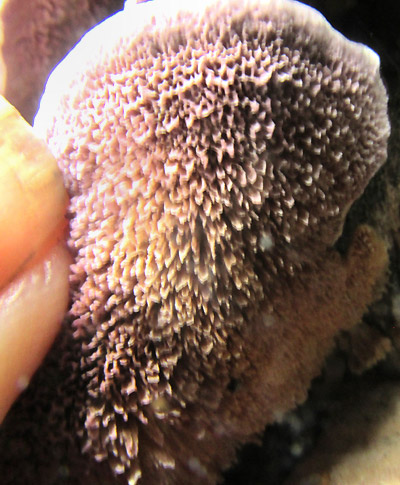Excerpts from Jim Conrad's
Naturalist Newsletter
Entry dated November 11, 2023, from notes taken on slope earlier very eroded with deep gullies in compacted volcanic ash, or tuff, now reforested with pines about 15 years old; 1.5km SW of community of San Pablo, municipality of Almeaco de Bonfil; N20.0785°, W99.9941°, elevation 2600 meters (8530 feet); extreme southern Querétaro state, MÉXICO
VIOLET-TOOTHED POLYPORE

The above shelf fungus formed a healthy community on a decaying tree stump. The stump was noteworthy because this slope had been completely deforested earlier, erosion had created extensive, deep gullying, and now this stump was the only relict of how it was before the current young forest of same-sized pines planted in straight rows had grown up. Judging from the burls and bark, I think the stump was of an oak tree. More intact forests at this elevation in this area are mostly oak.


The fungus, with alternating zones or bands of different colors atop its cap is one of several shelf fungi referred to as turkeytails. Several often-unrelated species go by the turkeytail name, such as the "False" Turkeytail, and what's just known as Turkeytail. To sort them out, the first step is to check a cap's undersurface, this one's shown at the right. Instead of displaying the "real" Turkeytail's many tiny pores, or the "false" Turkeytail's fairly smooth undersurface, this one bore many crowded, pale-violet "teeth." The teeth were the remains of breaking up tubes, in the inner surfaces of which reproductive spores develop and descend, to be dispersed by the wind.
This was the prettiest turkeytail species I'd ever seen. In pine-bough-filtered sunlight of clear mountain air, the fungus's violet-colored margins highlighted by slender white rims seem to glow with an interior light. With such a distinctive feature, it was easy to identify our fungus as a member of the genus Trichaptum.
Within the genus Trichaptum, our fungus could be one of two species: Trichaptum biforme, occurring on decaying hardwood logs and stumps, or Trichaptum abietinum, found on coniferous tree logs and stumps. Michael Kuo of the MushroomExpert.Com website says that the two species "look nearly identical," and it's possible that I'm wrong about our fungus's stump being oak instead of pine, so other distinctive differences were sought.
I read that the hairs on Trichaptum abietinum are coarse and stiff, while those atop Trichaptum biforme are soft and velvety; I distinctly recall our fungus's top feeling soft and velvety, so I'm calling it TRICHAPTUM BIFORME, even though the other species seem to be more frequently documented in our area. Our Trichaptum biforme commonly is called the Velvet-toothed Polypore. Also I read that the cap's rim is violet only on fresh, growing individuals. Internet images indicate that later in the season when they're dried out, the two similar species really can be hard to distinguish.
Most literature currently available assigns the genus Trichaptum to the Polypore order, the Polyporales, thus the "Polypore" in the common name. However, the 2023 genetic study by M. Zhou and others entitled "Updated systematics of Trichaptum s.l. (Hymenochaetales, Basidiomycota)," convincingly asserts that Trichaptum belongs in the order Hymenochaetales, an order with no commonly used English name. For a taxon to be shifted to a different order is a big deal. For example, among us mammals, we humans are members of the Primates Order; bats are members of the Bat Order, the Chiroptera; whales are members of the Whale Order, the Cetacea. In this fungus, outward appearances don't much agree with how the genes indicate the taxon evolved.
Trichaptum biforme occurs worldwide wherever decaying hardwood is available. It's a saprophyte whose network of threadlike hyphae growing inside the dead trunk decomposes the organic matter, thus providing critical service to the ecosystem by being an important link in the recycling of nutrients and energy.
The fungus's flesh is too tough and leathery to be edible, and I find no use of it in traditional medicine.